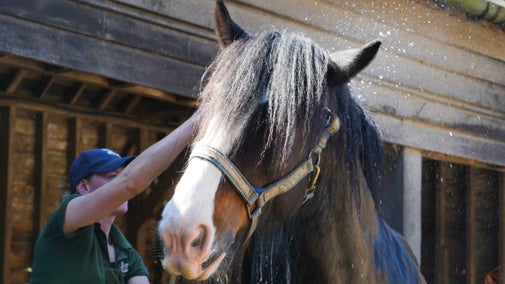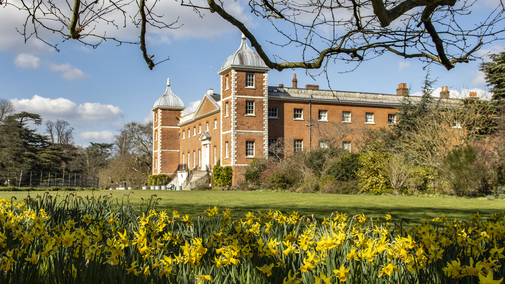
Discover more at Morden Hall Park
Find out how to get to Morden Hall Park, where to park, the things to see and do and more.

The Watermeads are just a short walk away from Morden Hall Park, and have recently been reopened after significant work, which has made them more appealing to people as well as local wildlife. Discover the history behind one of the first sites acquired by the National Trust.
Historically, the Watermeads, or ‘water meadows’, situated on the Morden side of the river Wandle, have been very important to the local population. During the Middle Ages, the area belonged to the powerful De La Mare family and was carefully managed to provide winter fodder and summer pasture for cattle.
In winter the land was allowed to flood and the rich Wandle silt increased the fertility of the soil. In spring, when the waters receded, the resulting grass crop was cut for hay. Cattle were then free to graze, or the sluices were opened and the land was flooded again to encourage a second batch of fodder.
The Wandle was an extremely productive milling river and in around 1800 the Watermeads became the site of a snuff mill and a paper mill built by mill owner Richard Glover. The mills had fallen into disuse some time before the National Trust purchased the land.

In 1913, an active campaign of fundraising, led by one of the National Trust's founders Octavia Hill, raised £1,050 to purchase the property from Sir Frederick Fowkes. This was one of the first sites acquired by the Trust.
Octavia had been greatly inspired by the sight of families and young children enjoying their visits to this riverside location. Sadly, she died the year before it was finally signed over to the Trust.
A stone seat overlooking the mill-cut commemorates her sister, Miranda, a local teacher who also contributed to the improvement of living conditions for the poor.
Between the wars, the River Wandle Open Spaces Committee and the National Trust funded a major planting initiative.
A wide range of ornamental trees and shrubs were added, both for autumn colour and as potential nesting sites for birds. It was later planted as an osier bed (a fast-growing willow used for basket-weaving) and there were also two plantations of cricket-bat willow.
This initiative continued during and immediately after the Second World War under the supervision of a dedicated member of the Open Spaces Committee, Tom Francis.
In 1946 he encouraged boys from the local schools to plant new trees in the Watermeads, saying ‘after six years of destruction it was a good thing to add a little beauty to the world.’
Unfortunately, adding non-native trees has had mixed results, altering the appearance of the Watermeads and clogging parts of the wetland habitat.
Since the Second World War, we have concentrated on developing the Watermeads as a nature reserve, working hard to open up the space, and in the last few years we’ve been carrying out repairs and creating a more natural environment for indigenous plants and wildlife, that’s also safer to access.

The progress on rehabilitating the Watermeads has come on apace since 2015 when we received significant grants, notably from the Big Green Fund, to help improve access to the area. Trees are being pollarded and coppiced in woodland management cycles.
Non-native aquatic invasive species, such as Japanese knotweed and floating pennywort, are being eradicated in environmentally friendly ways. We are managing the grassland with regular cutting, and planting wildflower meadows in an effort to encourage indigenous wildlife such as butterflies and mammals.
Now the work to strengthen the fragile wooden bridges is complete, the area is secure and the Watermeads are open again.
You will be able to enjoy the pleasures of this haven of peace, such as sitting by the Jack Pond, named after the male pike that can be fished for from its banks, the site of many a picnic or party. You can watch the permit-holding members of the Morden Hall Park angling club try their luck at catching the elusive fish.

Find out how to get to Morden Hall Park, where to park, the things to see and do and more.

Delve into the past at Morden Hall Park, home to snuff mills, a restored rose garden, and children’s parties.

Learn about how we‘ve preserved traditional methods of looking after the land and the wildlife that lives there, and find out how you can get involved.

Discover the network of footpaths and cycling trails – with routes suitable for pushchairs, dogs and wheelchairs, everyone can explore this place.

From river and wetland walks, to remnants of the park's history and an adventure playground for the little ones, see how the park changes along with the seasons.

From intimate spaces and modernist masterpieces to thriving wetlands and sprawling estates, London has it all, if you know where to look.

Explore some of the finest landscapes in our care on coastal paths, accessible trails, woodland walks and everything in between. Find the best places to walk near you.

Plan a visit to one of the special countryside places in our care and discover the benefits of being in the great outdoors. Pack your walking boots and get ready to explore woodlands, valleys and rivers.